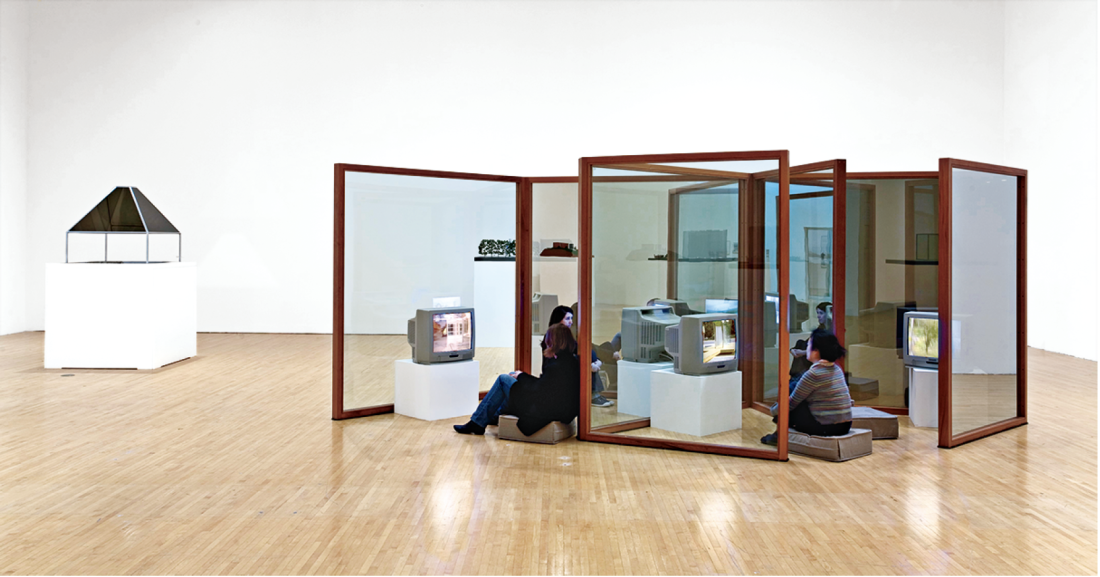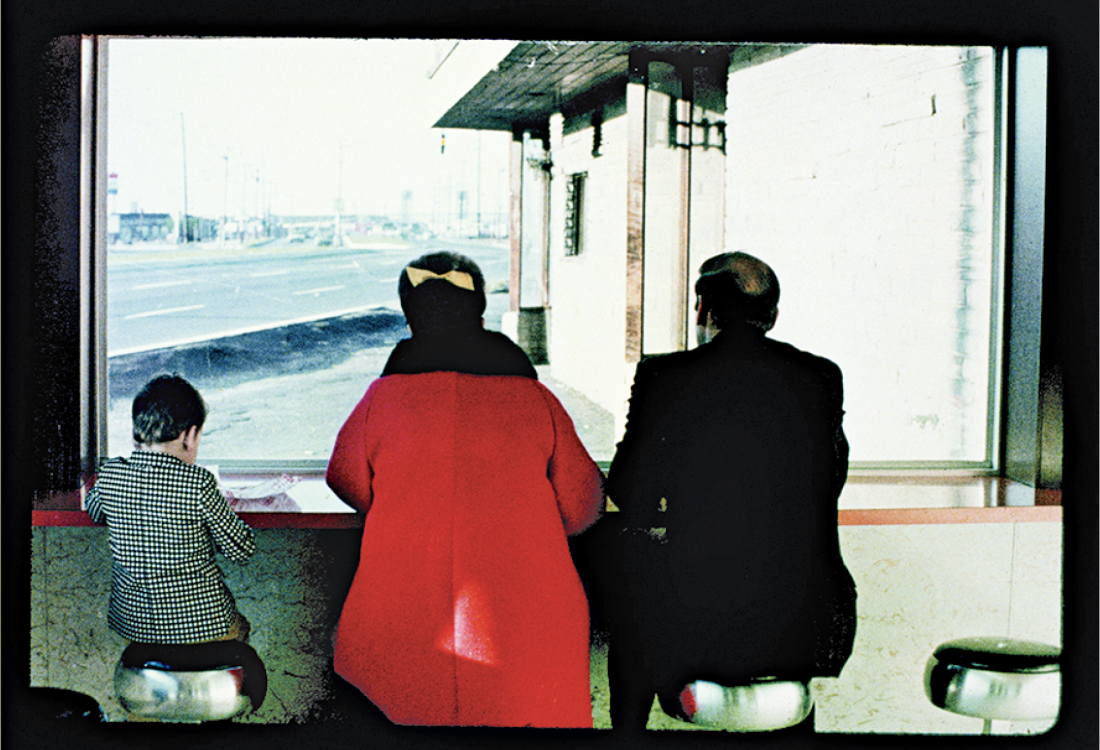Dan Graham
“Dan Graham: Beyond,” the first American retrospective of the work of the 67-year-old New York-based artist, details the various strands of a long career that began with Graham’s co-founding the John Daniels Gallery in 1964 in New York and continues today with the site-specific glass pavilions he creates for sculpture gardens and interior space commissions all over the world. Bringing a large ensemble of works by Graham, who has primarily exhibited in Europe and Canada, to three venues in the United States (“Beyond” opened at Museum of Contemporary Art, Los Angeles, before travelling to the Whitney Museum of American Art and Minneapolis’s Walker Art Center) demystifies the career of an artist whose legendary status too often obscures his actual production. Major American museums of modern and contemporary art still do not own an example of his work, and few contemporary art surveys go beyond his “Homes for America,” a series of photos Graham took in the mid-1960s of New Jersey suburban tract housing. “Homes” first appeared as a slide presentation and was later published in Arts Magazine.
The retrospective, organized by the Whitney’s Chrissie Iles with Bennett Simpson of the Museum of Contemporary Art, Los Angeles, illustrates the full breadth of Dan Graham’s career, charting his jumps from text and photo-based art to performances, film, and video and later to architectural installations. Graham was born in Urbana, Illinois, and raised in northern New Jersey. A self-described “dropout,” he did not attend college or art school but read widely with the intention of becoming a published writer. Learning of the New York gallery scene in the pages of Esquire, he and two friends pooled resources to open the John Daniels Gallery. Graham, as the gallery’s director, organized shows featuring early work by Donald Judd, Jo Baer, Dan Flavin, Sol LeWitt and Robert Smithson before the gallery went bankrupt. Returning home to New Jersey, he began work on a series of photo and text pieces that he passed along to friends but had little success with submitting to magazine editors.

Installation view of “Dan Graham: Beyond” at the Museum of Contemporary Art, Los Angeles (MOCA), 2009. Photo by Brian Forrest. Courtesy Whitney Museum of American Art.
Work from this period, which includes Figurative, a reproduction of a cash receipt created in 1965 and later published amidst ads in the March 1968 issue of Harper’s Bazaar, was framed and hung near the rear of the Whitney’s floor-wide installation. Even in these seemingly dry, data-based pieces, there are the traces of anarchic humour that gave works of Pop, systems art and minimalism their edge and became central components of his later work. Like Hans Haacke, Graham was fascinated by the formalization of the art world and was determined to have fun at its expense. He tells interviewer Nicolás Guagnini, “Through the actual experience of running a gallery, I learned that if a work of art wasn’t written about and reproduced in a magazine, it would have difficulty attaining the status of art.” Graham decided to “put things in printed matter into magazines as magazine pages,” he said, so that they would devalue art. “They would be disposable,” being about “the magazine system” and “art criticism at the same time.”
Much of the work on view, including the remarkable Rock My Religion, 1982–1984, a 55-minute video essay exploring the links between Puritanism and rock and roll in America, and Artists’ and Architects’ Works That Influenced Me, 2009, a text-and-slide presentation in which Graham plainly presents works he considers influential, resembles auxiliary programming traditionally organized to illuminate a major museum retrospective but were instead presented as central works of art in the retrospective.
Following the placement of his pieces in magazines, devaluing the work to a practice where it seemed odd to see it framed on the wall of a museum, Graham melded his work in other media with his experiments in art. Accepting the union of the expository and art making is a prerequisite for engaging with the work of “Dan Graham: Beyond.” Even the most sympathetically minded visitor might remain reluctant to accept fully some of the work as art. Roberta Smith, in her glowing review of the retrospective in the New York Times, called Graham’s work “quasi art,” defining it as “an elaborately narrated philosophical inquiry into the nature of art and its context….” Graham apparently agrees, often contending with interviewers that art is only a hobby for him, secondary to work as a cultural critic and professor. He has taught at the University of California at San Diego and the Nova Scotia College of Art & Design in Halifax, where many of his performances developed as classroom experiments.

Dan Graham, detail from Homes for America, 1966–67, 20 35-mm slides and carousel projector, dimensions variable. Courtesy of the artist, Marian Goodman Gallery, New York and Paris, and Whitney Museum of American Art.
The catalogue essays in “Dan Graham: Beyond” rely on Graham’s writing for explanations of his art production. Chrissie Iles, in discussing the performance work of the late sixties and seventies, wrote that Graham’s “model emerged in 1969, the same year he wrote two major articles, ‘Subject Matter’ and ‘Dean Martin/Entertainment as Theater,’ both of which set out the trajectory of his thinking.” She considers his performance Lax/Relax, 1969, in which Graham repeated the word “Relax” while a recorded female voice repeated the word “Lax,” as an illustration of his essay, published in the rock magazine Fusion, on Dean Martin’s relationship to his on-screen guests and the audience in the television program The Dean Martin Show.
The glass pavilions, which spread across the Whitney’s floor and received the most attention from visitors, similarly accrue meaning through Graham’s own writing. In a piece titled “Garden as Theater as Museum,” written in 1989, he places his glass and metal structures, which often confuse public and private space through the use of semi-reflective glazing, in the context of English and French garden design and the emergence of modern museums, amusement parks, suburbanization and corporate atriums.
Like the greatest artists of the post-minimalist moment, during which one could, in his words, “do anything and call it art,” Dan Graham is unconcerned with his work’s uncomfortable relationship to traditional art. Evident in the good-natured jokes built into his performances and the popularity of his understated public installations, Graham succeeds by ignoring the identity crisis that crippled later artists struggling to find a place in an expanded field that placed art amidst architecture and entertainment. Dan Graham revels in it. ❚
“Dan Graham: Beyond” was exhibited at the Whitney Museum of American Art in New York from June 25 to October 11, 2009. It began its tour at the Museum of Contemporary Art in Los Angeles and continues to the Walker Art Center in Minneapolis.
Alexander B D Kauffman writes on contemporary art and architecture. He lives in New York and Swarthmore, Pennsylvania.

